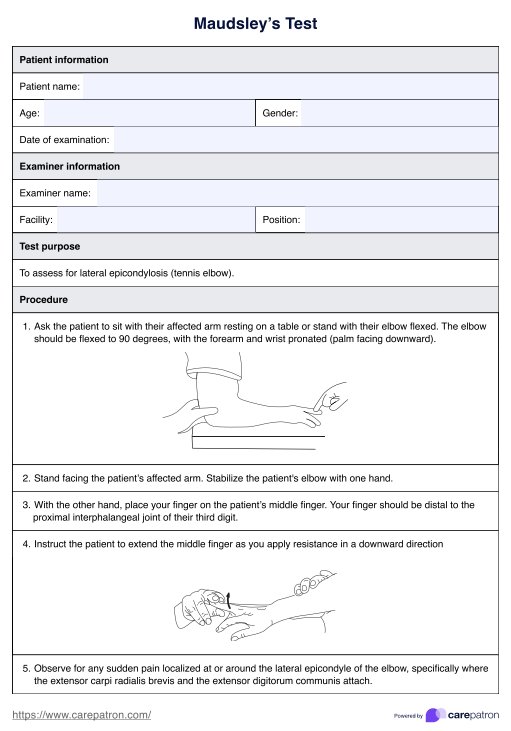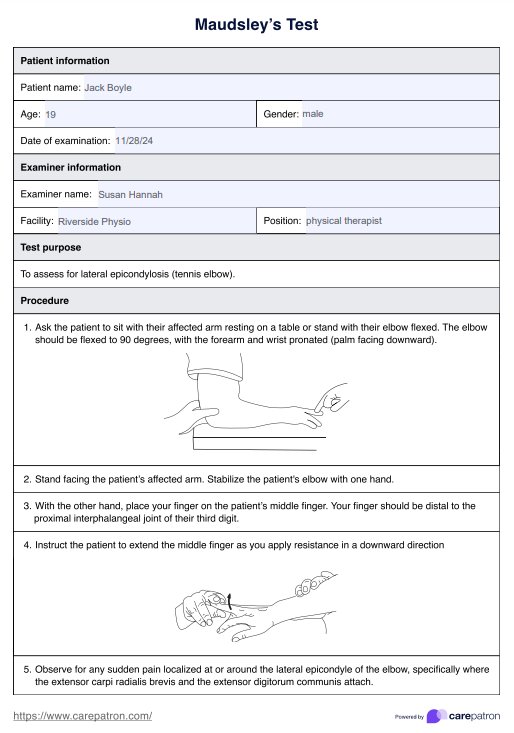Maudsley's Test
Discover a Maudsley's Test Template for accurate diagnosis of tennis elbow. Learn how to perform Maudsley's Test with precision here!


What is Maudsley's Test?
Maudsley's Test, also known as the resisted-middle-finger-extension test, is a specific diagnostic maneuver used to identify lateral epicondylosis (sometimes called lateral epicondylitis). More commonly known as tennis elbow, this condition affects the tendons attached to the lateral epicondyle of the elbow, particularly the extensor carpi radialis brevis and the extensor digitorum communis.
Maudsley's Test explicitly targets the extensor digitorum communis slip muscle group, which shares a common extensor tendon with other wrist and finger extensors. A positive result is indicated by the elicitation of sudden pain at the lateral elbow, particularly over the patient's lateral epicondyle, when the middle finger is extended against resistance. This pain suggests explicit damage to the extensor digitorum communis and related extensor muscle slips, which are stressed during the test.
The test is valued for its diagnostic accuracy in confirming lateral elbow tendinopathy. It's one of several examination tests used to diagnose elbow injuries and is often used in a comprehensive physical examination. Maudsley's Test can help differentiate lateral epicondylosis from other conditions, such as radial nerve entrapment. The test's ability to isolate specific muscle actions and pinpoint pain helps confirm the diagnosis and guide treatment evaluation.
Positive results from Maudsley's Test help in formulating targeted treatments for tennis elbow. Understanding the specific anatomical damage enhances conservative and surgical management, improving patient outcomes. Further research into the anatomical and clinical findings associated with the test could refine its utility, improving sensitivity and specificity in diagnosing tennis elbow and similar conditions.
Maudsley's Test Template
Maudsley's Test Example
How to use our Maudsley's Test Template
To effectively use the Maudsley's Test Template in a clinical setting, follow these steps:
Step 1: Access the template
Access your free printable Maudsley's Test Template by following the link on this page. Record the examiner's name, position (such as a physical therapist or orthopedic specialist), and the facility where the test is conducted.
Step 2: Input patient information
Fill in the patient's full name, age, gender, and the examination date. This information is crucial for record-keeping and future reference.
Step 3: Conduct the test
Perform Maudsley's test to assess for lateral epicondylosis (tennis elbow) by following the steps on the template. Make sure to observe and record the patient's response to the resistance, particularly noting any pain around the lateral epicondyle:
- Ask the patient to sit with their affected arm resting on a table or stand with their elbow flexed. The elbow should be flexed to 90 degrees, with the forearm and wrist pronated (palm facing downward).
- Stand facing the patient’s affected arm. Stabilize the patient's elbow with one hand.
- With the other hand, place your finger on the patient’s middle finger. Your finger should be distal to the proximal interphalangeal joint of their third digit.
- Instruct the patient to extend the middle finger as you apply resistance in a downward direction.
- Observe for any sudden pain localized at or around the lateral epicondyle of the elbow, specifically where the extensor carpi radialis brevis and the extensor digitorum communis attach.
Step 4: Interpret the results
Mark the test as positive or negative based on the patient's pain response. Note pain localization and severity, as well as any additional observations, such as patient discomfort levels during the test or other symptoms. Ensure you document which elbow was affected.
Step 5: Complete the assessment
Make recommendations to the patient based on the test outcome, such as additional diagnostic tests, physical therapy, or a follow-up appointment. Sign the document to validate the test results and formalize the examination process.
Results and interpretation of Maudsley's Test
The results of Maudsley's Test are interpreted based on the patient's pain response during resisted middle finger extension:
- Positive: If the patient experiences sudden, sharp pain over the lateral epicondyle or surrounding region during the test, it suggests a positive result. This pain is indicative of lateral epicondylosis (tennis elbow). This implies damage to the extensor carpi radialis brevis or extensor digitorum communis tendons, which are part of the common extensor tendon attaching at the lateral epicondyle.
- Negative: The result is negative if the patient does not feel pain or only experiences mild discomfort not explicitly localized to the lateral elbow. This suggests that lateral epicondylosis may not be present, or at least not the primary source of pain.
Although this is a diagnostic test, accuracy in detection of lateral epicondylosis depends how correctly the test was conducted. Maudsley's Test helps to confirm or disconfirm lateral epicondylosis, but may not differentiate it from other conditions like radial nerve entrapment. A positive test should be interpreted within a comprehensive clinical evaluation, including patient history, additional manual tests confirm a lateral epicondylosis diagnosis and imaging if necessary.
Next steps after Maudsley's Test
After conducting Maudsley's Test and obtaining the results, the next steps include:
Imaging and diagnostic confirmation
If a positive Maudsley's Test result is obtained, you may need to perform additional physical examination techniques (such as Cozen's or Mill's Tests) to confirm a lateral epicondylosis diagnosis.
If your patient is experiencing tendon pain or discomfort, you may recommend imaging tests like ultrasound or MRI. These tests can provide a detailed evaluation of your tendons and help rule out other conditions.
Evaluate the injury severity
Perform wrist extension tests, focusing on the extensor digitorum communis, with the elbow fully extended and fully flexed. Use isometric middle finger resistance tests to identify pain levels. Also consider the patient's complaints of pain during forearm pronation and wrist extension. MRI and ultrasound scans can also confirm if there is tendon degeneration, inflammation, or tears.
Initial treatment
Instruct the patient to avoid all activity that may aggravate symptoms or worsen the injury in the days following in the injury (such as work and physical activity). Adjust daily tasks to minimise tendon stress. Using an elbow brace or strap can relieve strain. Applying ice or a cold compress to the elbow can help with pain relief and swelling, as well as over the counter pain relief like ibuprofen. You may also recommend NSAID creams or gels.
Create a treatment plan
Use a comprehensive, patient-focused approach to create a recovery plan and manage discomfort from tennis elbow. Treatment often focuses on reducing pain and inflammation while promoting tendon healing. Common treatment options include:
- Physical therapy exercises to restore flexibility and strength. Therapists may use ultrasound, massage, or eccentric exercises. Include exercises for the wrist and elbow, such as isometric finger resistance and wrist extensions, to strengthen extensor muscles.
- Acupuncture and dry needling can relieve pain and improve function.
- High-energy shock waves stimulate healing and reduce pain in cases of chronic tennis elbow.
Monitoring and follow-up
Monitor the patient regularly to track recovery and discomfort levels as treatment progresses. Adjust their treatment plan if needed. In severe or persistent cases, surgery may be required to remove damaged tissue or to release the affected tendon. This is considered when symptoms persist after 6-12 months.
Benefits of using the Maudsley's Test Template
There are several advantages to using the Maudsley's Test Template when conducting physical evaluations of elbow pain and injury. Here are some of the key benefits:
Improved accuracy
The Maudsley's Test Template provides straightforward and easy-to-follow directions to aid clinicians in correctly performing Maudsley's Test. Improved accuracy means the utility of the test as a quick, affordable and reliable tennis elbow test is increased.
Increased diagnostic reliability
This template ensures clinicians perform Maudsley's Test accurately and record their observations in a thorough and comprehensive way. This supports healthcare providers to accurately evaluate whether lateral epicondylosis is present and have confidence in their clinical findings.
Comprehensive information-gathering
Using our Maudsley's Test Template ensures all essential information about the patient and their condition is collected and organised. Accurate record-keeping facilitates complete and accurate evaluations and effective treatment plans tailored to the patient's needs.
Commonly asked questions
Maudsley's Test is an orthopedic physical exam technique used to confirm suspected cases of lateral epicondylosis (tennis elbow).
Initial treatments include rest, ice therapy, and anti-inflammatory medications. Physical therapy exercises, bracing, and activity modification are recommended as tennis elbow heals. Severe cases may require injections or surgery for full recovery.
Lateral epicondylosis is caused by overuse of the forearm muscles due to repetitive motions (such as gripping or lifting) leads to microscopic tears in the tendons near the lateral epicondyle, resulting in pain and sometimes inflammation.
Physical therapy, rest, and over-the-counter pain relievers work well initially. In stubborn cases, corticosteroid injections, PRP therapy, or surgery may be needed.







































































































